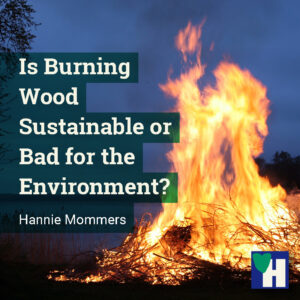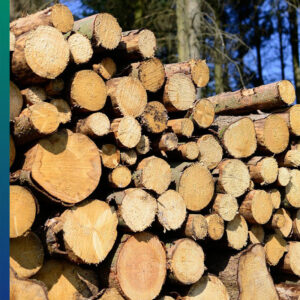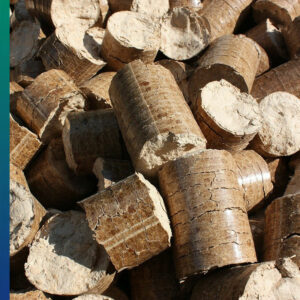
From a young age, I have hated fireplaces and open fires. Probably because my bronchitis often made it difficult to breathe freely and because I didn’t like the smell.
Until I was 15, my parents had a coal stove. It partly had the same disadvantage as a fireplace: if you stand in front of it your face burns and at the back, your tushy freezes off. I thought the central heating that we had, later on, was a lot more pleasant.
For many, a fireplace represents coziness. But is burning wood sustainable or bad for the environment? And if it’s the latter, are there sustainable alternatives?
Some of the links are affiliate links. As an affiliate associate, we earn a commission when you purchase any of the products offered through the shared links at no extra cost for you. This helps us maintain this website.
Table of contents
Is burning wood sustainable?
Compared to fossil fuels, burning wood is more sustainable because less CO2 is emitted. Trees grow faster than oil or gas is formed. On the other hand, particulate matter and soot cause nuisance. People suffer from the smoke and the environment is burdened heavily.
BBQ, the pinnacle of fun?

At a young age when I was in school, I was often an outsider and that hasn’t changed: you don’t do me any favors with a barbecue. In that respect, I am not in a good place here in Spain.
A celebration here is always with lots of food. By the way, contrary to popular belief, without much alcohol. It is the foreigners who drink the most alcohol.
And because of the good weather, those meals are often prepared outside.
The whole family goes to the campo. The children look for dry branches on the ground. The women prepare Paella or Mijas on the wood fire. The men barbecue the meat.
We are regularly invited by a friend who participates in cooking competitions on wood fires. Despite showering right away and throwing our clothes in the washing machine as soon as we get home, we still smell like smoke for days.
Reasons to avoid wood-burning
Trees absorb many types of pollutants produced by humans. Toxins collect in wood fiber, so burning trees releases these concentrated toxins back into the atmosphere, or worse, in our houses.
These toxic materials, which include benzo-a-pyrene, benzene, and formaldehyde, are the cause of the long-term health effects of wood fires.
Formaldehyde and polychlorinated biphenyls, also known as PCBs, are commonly found in industrially manufactured wood used for fireplace logs and wood-burning stoves.
The condensing wood tar vapor and other gasses in wood smoke form tiny droplets that are nearly invisible. They are floating and airborne due to their size. Furthermore, the particles are small enough to be breathed deep into the lungs, causing lung diseases.
Related: What are the Positive Effects of Deforestation or are the Negative Effects Worse?
When burning wood is the only option

There is not always a choice, sometimes wood is the only available fuel. In that case, you can pay attention to the following tips to be as sustainable as possible.
Avoid smoke as much as possible
Smoke contains soot and particulate matter, which is bad for people and the environment. In some countries, it is illegal to burn a fireplace when it is foggy or windless because the smoke settles and is not spread due to inversion.
Households are impacted by wood smoke due to indoor air pollution. As a simple rule, if you can smell wood smoke, you are breathing in wood smoke.
Ensure a good draft and sufficient oxygen
Fire needs oxygen. If the house is insulated ‘too well’ or if the exhaust hood is on, negative air pressure can occur. The solution is to open a window. Have the chimney checked and cleaned regularly.
Good combustion produces the least CO2

If the fire has yellow, quiet flames, it will have as little smoke as possible. Do not use too much wood at once, let the fire burn evenly, and put wood on it again in time.
Among the major components of internal combustion exhaust is carbon monoxide, a deadly gas.
Use local wood
Transport generally uses a lot of fossil fuel, so it’s best to use local wood. Let the wood dry thoroughly before firing.
Some materials are not good
Not all wood is suitable for the stove or fireplace. Firing painted, stained, or impregnated wood is not allowed, because during combustion harmful substances, such as heavy metals, are released. The same is true for plywood and chipboard.
Never put household waste, plastic, or printed paper in the fireplace. Here in Spain, garbage is often burned in the campo, even car tires and plastic are thrown into the fire. Horrible.
Related: 19 Reasons Why Trees are Vital to the World, including Us
Eco-friendly alternatives to burning wood in your fireplace

- Wood pellets;
- Biomass bricks;
- Soy and switchgrass logs;
- Recycled coffee grounds;
- Compressed paper bricks;
- Non-petroleum natural wax logs.
Gas fireplace
It is a bigger investment to convert the fireplace into a gas fireplace. Yet, if you like watching the flames, there are good options with a gas fireplace.
The disadvantage is of course that gas is also a fossil fuel. The advantage is that there is less soot and smoke and a gas fireplace requires less cleaning time than an open fireplace.
Electric fireplace
Especially when you own solar panels, an electric fireplace is a good alternative. There are models that almost look like a traditional wood fireplace. The operation is much easier because you can regulate the heat with the push of a button. No chimney is needed, so installation is simple as well.
Related: Low-Carbon Transportation is Not Enough, More is Urgently Required
Burning wood as decoration
A completely different way of burning wood is decorating wood, also known as pyrography. With a wood burner, a device that is very similar to a soldering iron, texts and drawings can be burned into the wood.
It seems to me that you should not hang too close to your work when you are burning the wood. But the result is long-lasting and weatherproof. And with practice, the most wonderful results can be achieved.
Some final words
Considered closely, most human actions pollute the environment. We just want to be able to live our lives, preferably protected and warm.
We can do our best to find the least polluting solutions for what we want to achieve. At times, we will have to give up something dear to do so or we will have to make an extra effort.
By thinking not only of our own benefit but also of the public interest, we can do that.
Do you like wood fire? Tell us in the comment box below.



We recently installed our first gas fireplace and I couldn’t be happier with it! The maintenance is ten times less of a hassle and my fiance doesn’t have to constantly worry about possible hazards. Plus, the whole thing along with installing it ended up costing a lot less than we initially predicted.
Gas is better for our health than wood, so, good for you! It’s a fossil fuel though which makes it a second-best choice, I think. Gas will vanish in a couple of decades because then the gas bubbles will be empty.
Anyway, good for you to have a healthier alternative now. Thanks for your comment and stay healthy, Ashley.